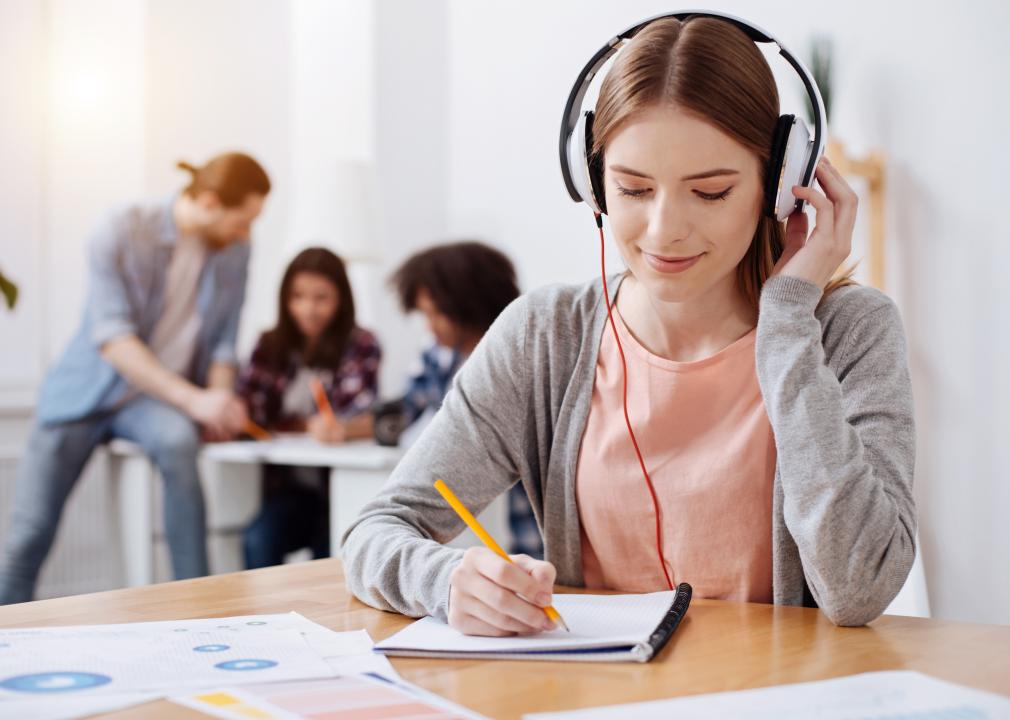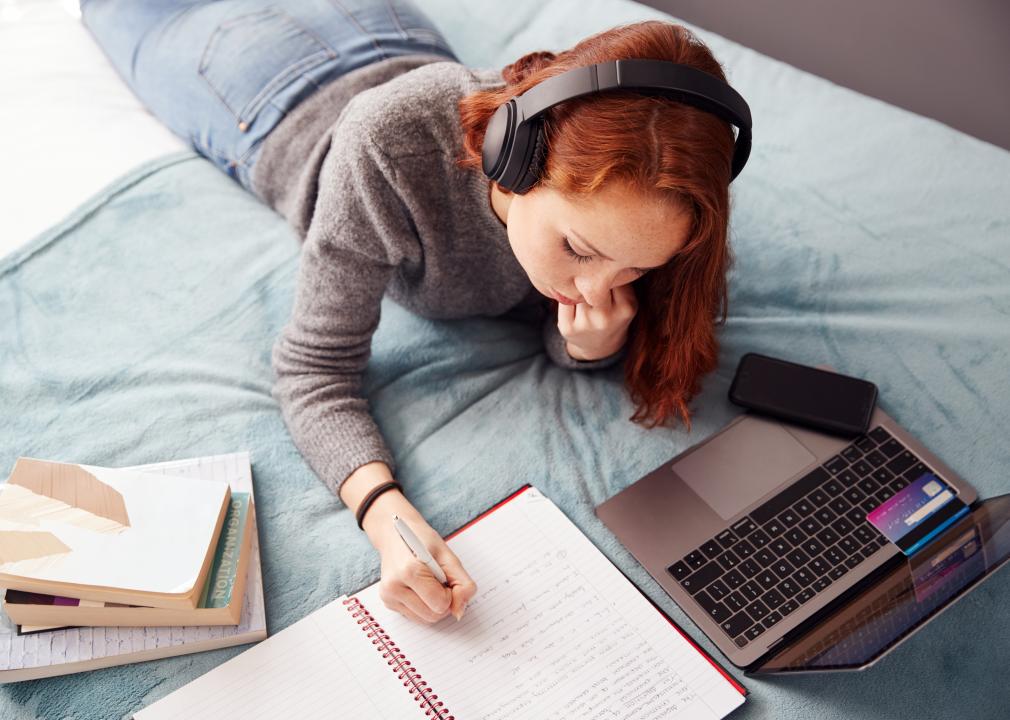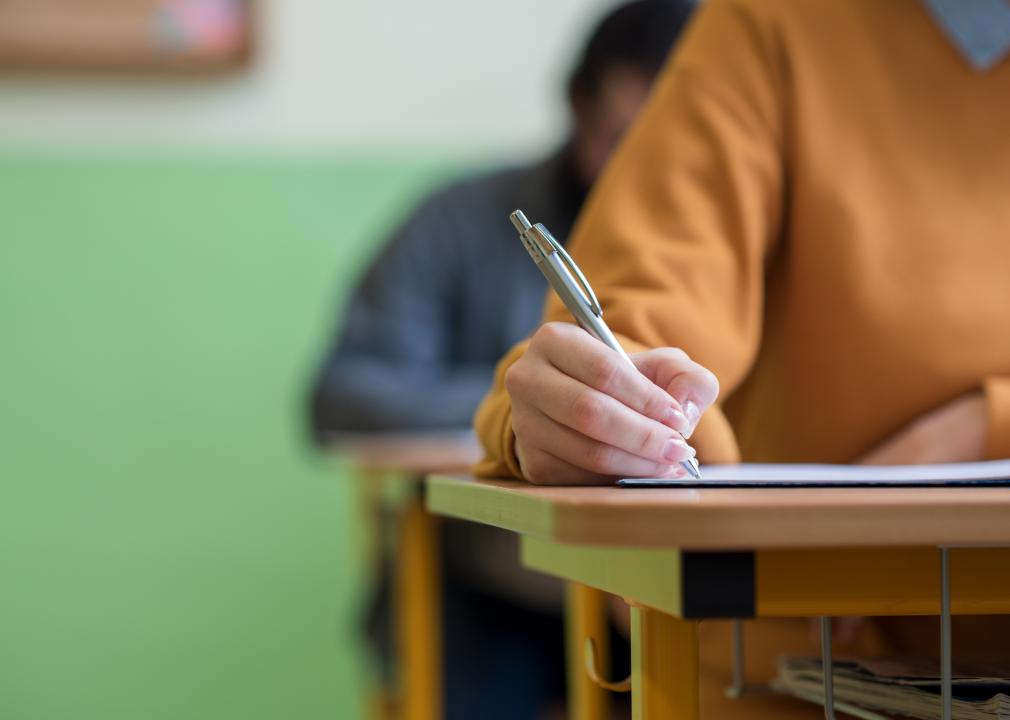When colleges adapt to meet accessibility needs, they're met with students who thrive, data shows
YAKOBCHUK VIACHESLAV // Shutterstock
When colleges adapt to meet accessibility needs, they’re met with students who thrive, data shows
Young student writing a transcript.
Jessica McCabe was an A student in high school, so she assumed she would breeze through her college classes. That didn’t happen. “I am one of many college dropouts who felt she was ‘too smart’ to need accommodations,” she told Stacker. “I was wrong.”
McCabe, who has attention deficit hyperactivity disorder, is one of many undergraduates who don’t complete their bachelor’s degree. Nearly 2 in 5 undergraduates drop out, according to the Education Data Initiative. For those like McCabe, a lack of necessary accommodations presents a barrier to thriving in higher education settings.
About 1 in 5 college undergraduates reported having some type of disability in the 2019-2020 school year, according to the National Center for Education Statistics. That includes students with physical, mental, or emotional conditions that may require physical or digital accommodations to be successful.
A college accommodation is any adjustment made “to remove barriers for students with disabilities,” Elizabeth C. Hamblet, a college disability services specialist and author of “Seven Steps to College Success,” told Stacker.
Additionally, Marvin Williams, director of disability resource services at California State University, Stanislaus, told Stacker that such accommodations are designed to “help an individual with a disability be able to have access to the curriculum.”
Many campus accommodations are guaranteed by the Americans with Disabilities Act Amendments Act of 2008. However, as technology has changed, so have accommodations. The rise of digital testing and other types of tech-driven learning and assessment have increased the need for digital accessibility.
Examining academic studies and other research, accessiBe also spoke to experts to better understand how colleges and universities are adapting to meet students’ evolving digital accessibility needs.
![]()
Monkey Business Images // Shutterstock
Stigma, lack of awareness make students reluctant to access services
Female student on bed working on schoolwork.
“Students may not realize they need accommodations or have trouble obtaining them,” said McCabe, author of “How to ADHD” and host of a YouTube channel by the same name.
In a study of students who reported disabilities in high school, only about 2 in 3 informed their colleges about their disabilities. When they did, responses from their institutions varied. Just over 4 in 5 students who attended four-year colleges reported receiving their requested accommodations or services, compared to just over half of students at two-year colleges. Among students who reported a disability, about 3 in 5 received help from their school, versus half of those who did not report a disability, according to the NCES.
Under the ADAAA, public and private colleges that receive federal funding are required to provide accommodations for students with a wide range of disabilities. It furthers requirements laid out under the 1973 Rehabilitation Act, the first federal law designed to protect the rights of students with disabilities, facilities and communications.
However, as communications have become predominantly digital, concerns about accessibility on websites and other digital platforms still persist. With more colleges adding distance learning programs and online and hybrid courses continuing their rapid growth, digital accessibility is increasingly imperative to student success.
While accommodations tend to be specific and individualized, many people living with disabilities also benefit from accessible campuses. Modifications that allow all students to access the same facilities and services, including ramps, braille, or parking spaces reserved for students with physical disabilities, help mitigate or remove obstacles to learning and partaking in college life.
In order to receive college accommodations, students must first provide documentation of their disability, and register with their college’s disability services office, where they’ll then discuss the details of their accommodation to determine the most helpful path forward.
Some colleges have provided disability services beyond the legal requirements. If they do so, they can charge additional fees for those services, such as one-on-one tutoring or meetings with specialists.

Canva
Digital accessibility improves perception, understanding, operability
Four college students walk together on campus smiling.
Today, students spend as much—if not more—time learning and studying online as they do in the hallowed halls of university classrooms and libraries. Digital resources like course portals that house syllabi, discussion boards, and other course materials online, and learning platforms that provide support for large, impersonal lectures have in many regards increased academic access.
In other ways, however, digital advances have also widened the gap for students with disabilities. Whether it’s a school’s main homepage or an informational page for a specific course, sites that are incompatible with screen readers or have distracting pop-up windows, links to text that aren’t clear or obvious, and tables without headers can all be harder for students with impairments to access or decipher.
In accordance with legislation, ADA-compliant websites are perceivable, operable, understandable, and robust, or what’s known as the POUR framework, according to the National Center on Accessible Education Materials. These accessibility best practices take into account nuances, such as ensuring contrast between the text color and background color and using uppercase letters for each word in a hashtag (like #DisabilityAwarenessWeek).
Ensuring a website allows users to enlarge the text, and labeling links with descriptive text are best practices that make websites more perceivable and understandable, particularly for individuals with visual impairments. Providing captions and transcripts for videos and audio recordings can help those with hearing impairments; making sure students have enough time to access content and can navigate a site using a keyboard, mouse or other preferred tools can maximize operability.
Many schools do provide digital accommodations, such as digital books and transcription services, which can work in tandem with untimed testing, frequent breaks, or modified deadlines. Distraction-free settings and audio recordings of lectures are also extremely important for students like McCabe, who have ADHD and other forms of neurodivergence.
However, there’s still room for improvement. Often described as “intuitive” or user-friendly, classroom platforms that don’t meet web accessibility standards can be doubly frustrating for some students with disabilities. If accessing important resources and assignments online is a challenge, it can exacerbate feelings of shame, stress, or isolation that some students already struggle with in connection to their disability.
Despite challenges, many colleges are providing excellent services for students with disabilities. Adelphi University, Cornell University, and the University of Texas at Arlington are among several winners of the 2023 Higher Education Excellence in Diversity Award, which honors schools that are taking steps toward building an “inclusive and equitable space for individuals with disabilities,” according to Insight Into Diversity magazine. HEED winners have programs that set the bar for other institutions.
For instance, schools like the University of Connecticut offer assistive technology like screen readers for digital exams, note-taking technology, and captioning services that convert multimedia to speech and audio. These digital accommodations not only help level the playing field, but help build confidence as well.
“They’re not just meeting the requirements of the law, they obviously have the staff and the funding to go beyond that,” Hamblet said.
ABO PHOTOGRAPHY // Shutterstock
Setting the bar for accommodations
Students taking exam in classroom.
The impact of accommodations on student achievement is profound. A case study conducted by researchers at James Madison University found that students who were proactive about obtaining disability services earned higher grades than those who waited until after an academic crisis to get services. The most common reasons students didn’t seek out services initially were a lack of knowledge about available services, and the desire to forge an identity at college not defined by their disability, according to the study.
Disability stigma and a sense of shame may also make new college students reluctant to seek accommodations. In a 2019 study, researchers at the University of California, Davis, found that students with a disability, visible or not, tended to be avoided or pitied by peers. They may also experience bullying or discrimination, which can lead to anxiety and stress.
“What we typically see [is] folks coming in from high school want to try to be brave,” said Williams, explaining that students with disabilities who try to work “without a net” can “destroy themselves academically” because they want to attempt to do everything independently.
According to the Pew Research Center, creating more equitable spaces will require greater funding and research on student accommodations in higher education to better understand what is and isn’t working.
In order to make disability services more accessible to students initially, they need to feel empowered to reach out without shame or fear. Researchers at the University of Texas at Austin found that improving the disability office’s registration process and providing crucial information during enrollment or orientation can help students register for services with less friction.
Another way to ensure greater access is by increasing the number of mental health professionals who can assess students. “We need more mental health practitioners in the pipeline,” Williams emphasized.
Williams suggested another way to help students is by improving communication between high schools and colleges. Before committing to a college, Williams suggests students contact the disability office to learn more about the services offered. Says Williams, “Every individual is different, and their disability can impact them differently.”
This story originally appeared on accessiBe and was produced and
distributed in partnership with Stacker Studio.


